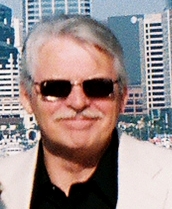 What we are about to share is our second offering of a transcript by Nicholas Gonzalez, M.D. speaking at the World Research Foundation. These records were recently discovered by the widow of Dr. Gonzalez and have been made available to the pubic. Over the next few weeks, we will continue to post the subsequent segments of Dr. Gonzalez’s story. The following transcript in addition to additional commentary was BROADCAST on July 6, 2022 on To Health With You! HERE is the LINK to listen! – Dr. Kelley’s Story ~ How It ALL Began – Part 2 ~ Editor
What we are about to share is our second offering of a transcript by Nicholas Gonzalez, M.D. speaking at the World Research Foundation. These records were recently discovered by the widow of Dr. Gonzalez and have been made available to the pubic. Over the next few weeks, we will continue to post the subsequent segments of Dr. Gonzalez’s story. The following transcript in addition to additional commentary was BROADCAST on July 6, 2022 on To Health With You! HERE is the LINK to listen! – Dr. Kelley’s Story ~ How It ALL Began – Part 2 ~ Editor
Dr. Kelley, Dr. Max Gerson, Dr. John Beard, Madame Curie and Dr. Edward Howell
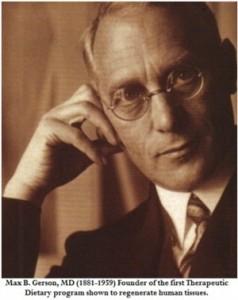 Dr. Kelley’s local library fortunately had a copy of Max Gerson‘s 1959 book called FIFTY CASES. Now Gerson was an interesting character in medical history, he was a very prominent German physician who during the forties and fifties developed his own personal approach to degenerative diseases involving primarily a diet of raw foods, nuts, seeds, grains, and lots of fresh vegetables juices: 8- 10 glasses a day. Now with this approach, Gerson had great success with a whole range of degenerative diseases, including cancer. During the thirties with the advent of Nazism, Gerson, being Jewish, left Germany and came to New York and set up his own clinic, for about a twenty year period continuing to have a fair amount of success using this particular diet.
Dr. Kelley’s local library fortunately had a copy of Max Gerson‘s 1959 book called FIFTY CASES. Now Gerson was an interesting character in medical history, he was a very prominent German physician who during the forties and fifties developed his own personal approach to degenerative diseases involving primarily a diet of raw foods, nuts, seeds, grains, and lots of fresh vegetables juices: 8- 10 glasses a day. Now with this approach, Gerson had great success with a whole range of degenerative diseases, including cancer. During the thirties with the advent of Nazism, Gerson, being Jewish, left Germany and came to New York and set up his own clinic, for about a twenty year period continuing to have a fair amount of success using this particular diet.
Gerson hypothesized that meat was somehow toxic to the human body and toxic to the liver, and raw fruits and raw vegetables helped the body clean out, stimulated the liver and made the immune system work better. He wasn’t too sure of the science, but he did know that the results were good. He published this in 1959. Kelley was a little ecstatic about this because it provided confirmation that the diet he was on really did have the possibility to work.
He got progressively stronger over a three to six month period, but he kind of stabilized. He was lucky, and I would say he was lucky in a very unlucky way. He was unlucky, of course, because he had pancreatic cancer. But he was lucky in that he had such bad cancer that the tumors protruded from his liver and he could feel them, so he could really monitor his own progress. He knew that when he got lazy on the diet, which he occasionally did, that those tumors would grow within days and he knew that if he stuck to the diet religiously, those tumors would regress. So he had his own ‘tumor marker’ sitting right there on his belly, he could feel these tumors. This was very fortunate. But about the sixth, seventh month those tumors didn’t shrink any more. And just about the time those tumors stopped shrinking, he developed severe digestive problems. Now the problem with pancreatic cancer is that it destroys the pancreas. Well, we know that the pancreas does: it produces insulin and it produces digestive enzymes. Without those digestive enzymes, you can’t digest food. One of the most common serious problems with patients with any kind of pancreatic disease, whether it be cancer or pancreatitis, is severe digestive problems, bloating, gas, nausea, vomiting, the dumping syndrome, constipation–they just can’t digest and utilize their nutrients properly.
Kelley figured there had to be some simple solution to this so he went to his local pharmacy and talked to the druggist who was a good friend of his, who said, that’s no big deal, just use some pancreatic enzymes. He pulled out a bottle of vibrant pancreatic enzymes, we’re talking 1964, he said, “Take these, they’ll provide the enzymes that your own pancreas isn’t producing, a very simple solution, it’ll take care of the gas and the bloating.” Well Kelley, if nothing else, was a man of excess, and if he was going to buy one bottle of the pancreatic enzymes he was going to buy a hundred, so he bought about ten cases of these enzymes, and that day started taking them. He started taking three with meals then four with meals then five with meals and after about three days he was taking about fifty capsules of pancreatic enzymes with each meal. And he noticed that something began to happen in his gut. Every time he took a dose of enzymes, there was a twinge of pain in the areas of the tumor in his liver. After a couple of weeks on these enzymes, he began to notice that these tumors seemed to actually be softening. In fact, he began to believe that after this period of the stabilization on the diet, they were actually shrinking, and dissolving. He said, this doesn’t make any sense. I take these enzymes, and within half an hour of taking them I feel some pain, some gnawing, something going on in these areas of tumor, but those enzymes are destroyed in the gut, I can’t conceive how this is possible. I don’t see what these pancreatic enzymes would have to do with those tumors in my liver.

(John Beard (1858 – 1924) published his “Trophablastic Theory of Cancer” in the The Lancet in 1902).
Kelley went to his library. Again, Kelley being a scientist, he was never satisfied without finding an answer. He looked up pancreatic enzymes by doing a literature search. And he was fortunate to find a name in the literature, Dr. John Beard, probably one of the most eminent men of the twentieth century and one of the least known men of the twentieth century. John Beard was an eminent embryologist working out of the University of Edinburgh in the 1880s and 1890s and around the turn of the century.
Dr. Beard, like Kelley, started out with no interest in cancer whatsoever. He was an embryologist, who was interested in comparative embryology, particularly in the placenta. His area of expertise was the placenta. Now we know what the placenta is. After fertilization in the mammal, the embryo produces an organ called the placenta which literally eats into the mother’s uterus. Now if it serves as an anchor to the growing fetus, it also serves as the connection between the blood supply of the mother which means nutrients to the baby. and the waste products to the baby, there’s a kind of a point of connection between the blood supplies of the baby and the mother, that’s how the baby is fed and that’s how the baby gets rid of its waste materials.
Beard was a smart man and he noticed that about the mammalian species that he studied, and he studied dozens, that the placenta would grow into the uterus and would grow and grow and grow and at a particular time in every species, it would suddenly stop growing. In mice it was ten days, in humans 56 days, in every human embryo, virtually to the day, 56 days and that placenta would stop growing, in elephants it was something like 300 days.
Beard was particularly interested in this because he realized something unusual about the placenta, and he was the first person to make this observation, but not the last. He saw the placenta as kind of like a tumor, because indeed it does behave like a tumor. The placenta is a piece of tissue that invades the mother’s uterus, much as a tumor would invade the mothers’ uterus. Now usually, the placenta reaches a certain point of growth, and stops. But sometimes it doesn’t, and in women where the placenta doesn’t stop growing, they develop a very serious cancer called chorliocarcinoma that used to be one of the most aggressive cancers around. Fortunately, there is a chemotherapeutic agent, methotrexate, that really does knock it out and now 80 to 90% of these women can be cured. Prior to the advent of methotrexate, it was a very, very deadly disease.
So, there was a tradition of the placenta behaving like a tumor, and Beard was aware of this. And he made the connection in his own mind, he said, “If I could figure out why the placenta stops growing at a certain point, 56 days in a mother, maybe I could figure out a way to stop tumors from growing. It was a great leap of faith, and it led to ten years of research. What they did is, in a variety of animal studies they investigated the growth and development of every organ system there was, the tissue of the organs, trying to find some connection between the development in the embryo and the cessation of growth in the placenta.
It took him ten years before he hit upon the fact that the only connection that existed, the only thing that changed, for example, day 56 in humans, 10 in the mice, day 300 in the elephants, was the day the placenta stopped growing, the embryonic pancreas started to work. There was no other connection. That’s kind of an interesting concept, because embryos don’t really need a pancreas. They get all the nutrition they need from their mother’s blood supply, they don’t need digestive enzymes, they get them for free right from the mother’s blood supply, they don’t have to chew it or digest it in fact their digestive system really is not function, is not needed until the day they’re born and they start eating through their mouths. Again on day 56, which is pretty [rare] in embryonic development, the placenta started working – it started producing pancreatic enzymes, and Beard said, “Listen, what possible function could these pancreatic enzymes have other than to stop the placenta from growing. And if indeed they do stop the placenta from growing perhaps, they could stop tumors from growing! “
In November of 1904, Beard presented his hypothesis that the pancreatic enzymes represent the main defense against cancer, not the immune system or any other system, he presented it before the Edinburgh Scientific Society, he was universally laughed at, and I said universally laughed at because there was one very bright army surgeon in the audience who was a cancer specialist, and of course in 1904 there was no cancer therapy other than surgery, and this guy had seen a lot of his patients die and he was willing to listen to anybody, even this crazy embryologist out of Edinburgh who proposed that pancreatic enzymes could cure cancer.
After the lecture, and all the booing and the throwing of tomatoes, this army surgeon went up to see Beard, and said, “I’d like to try your therapy. Well, in the next move, Beard and the army surgeon developed some injectable pancreatic enzymes. The first case documented in the medical literature was metastatic laryngeal cancer. Now even today, laryngeal cancer is a really nasty disease. It doesn’t have a real good prognosis. This man had metastatic disease where he had a huge tumor sitting in his throat. This Army Captain injected the enzymes with Beard’s assistance over a period of two weeks, and in two weeks that tumor was one day just thrown up by this patient, and they had it documented and it was dead.
This was the first documented case of a patient apparently cured by the use of injectable pancreatic enzymes. IT was published in the British Medical Journal and caused an enormous controversy. The usual controversy. The patient didn’t have cancer, the results were faked, that wasn’t really a tumor, the same things that we hear today. A number of doctors, however, did get interested in Beard’s work and over the following years about thirty or fifty papers were published in medical journals, both in the U.S. and in Europe documenting the regression of tumors and in fact some cures, with the use of injectable pancreatic enzymes.
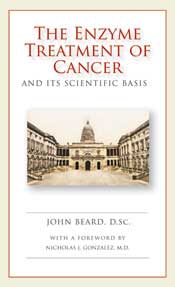
Now you say “that’s wonderful but why didn’t Beard’s work take hold it if was so wonderful?” In fact, in 1911, Beard published a book called “The Enzyme Theory of Cancer,” and I think that only about 15 people ever bothered to read it. The reason is that just about the time he published his book, Madame Curie announced that radiation was a safe, non-toxic cure for virtually all cancer.
Madame Curie had a fabulous reputation…and had done that wonderful work with radiation, and she proposed at that time that radiation was perfectly safe. It would take a generation of radiation oncologists to die from leukemia before we realized that it wasn’t as safe as we thought it was. She also was mistaken to believe it would be useful against virtually all cancer. There are very few cancers that are radiation sensitive for any prolonged period of time.
However, Madame Curie sold her work in the world’s press that this was the answer to cancer. Beard’s work was forgotten, and then he died in about 1920, he died in obscurity and his enzyme therapy was forgotten until Dr. Kelley in 1964 because of the use of pancreatic enzymes given to him by his local pharmacist began to suspect that those enzymes were getting rid of that tumor in his gut. There was one problem: Beard said the enzymes had to be injected, that they would be destroyed in the gut. In fact, every medical and dental student who has ever gone through dental or medical school in the U.S. or any other country was taught that all ingested pancreatic enzymes are wonderful digestive aids, but they’re destroyed in the gut and they are not absorbed active and intact in the gut, that doesn’t happen.
Kelley was taking the enzymes orally, and he said, “Wait a minute. You said they have to be injected. I’m taking them orally and I know something is going on here.”
He went back to the literature. Lo and behold, in the 1930 and 1940s, there were a whole series of wonderful experiments documenting that oral ingested pancreatic enzyme in both human and animal studies are absorbed active and intact in the gut and do serve wider physiological functions. The easiest way to document that is with a 24 hour urine collection. You feed a patient a huge amount of pancreatic enzymes then collect urine for 24 hours and you can see how much of those enzymes are going to be excreted in the urine. It turns out that virtually 100% of what you take orally comes out in the urine, not in the intestinal tract, which means they have to be absorbed. With that problem resolved, Kelley began to think about the raw diet he’d been on.
 Now remember, Kelley’s therapy began with his mother’s vegetarian diet: fruits, vegetables, seeds, nuts, grains, all raw, lots of juices. He said, I wonder why that diet stabilized me initially. He was kind of taken by this idea of Beard’s enzyme theory, he said, you know, raw food is a wonderful thing, it’s got lots of vitamins and minerals and trace elements and its loaded with nutrients, and this of course is widely recognized. He said, ‘When you cook food”, and his mother insisted that the food had to be raw, “when you cook food, you don’t really destroy too many of the vitamins and minerals and trace elements – most vitamins and minerals and trace elements are not sensitive to heat.”
Now remember, Kelley’s therapy began with his mother’s vegetarian diet: fruits, vegetables, seeds, nuts, grains, all raw, lots of juices. He said, I wonder why that diet stabilized me initially. He was kind of taken by this idea of Beard’s enzyme theory, he said, you know, raw food is a wonderful thing, it’s got lots of vitamins and minerals and trace elements and its loaded with nutrients, and this of course is widely recognized. He said, ‘When you cook food”, and his mother insisted that the food had to be raw, “when you cook food, you don’t really destroy too many of the vitamins and minerals and trace elements – most vitamins and minerals and trace elements are not sensitive to heat.”
So Kelley said, “Why does this diet have to be a raw diet? Why did Max Gerson use a raw diet? What is it about raw food that helps cancer patients?” And he kept thinking and thinking and thinking and thinking, and he said, well the vitamins and minerals and trace elements are not destroyed by heat. What is destroyed by heat? The only thing destroyed by heat are enzymes. Well, raw food is loaded with enzymes, it’s just packed with enzymes. Every cell in everybody has at least 50 thousand enzymes, so when you eat raw food, you’re getting a load of enzymes. When you cook food, you get nothing. Enzymes are heat sensitive. They’re destroyed and inactivated about 118 degrees Fahrenheit.
So, when we cook food, we don’t destroy the vitamins and minerals, but you destroy every enzyme in every cell in that food. It’s an important concept when you think about. When you think about it, we’re the only species in the history of the world–you know, one billion years of life and evolution– that cooks its food. Every other species of animal eats raw food except for us. We’re so bright that we decided that cooking food is better, we decided that–some anthropologists will tell you that 50,000 years ago, some say oh a couple of hundred thousand years ago we started to cook food. It tastes better when you cook it. If you give a dog some raw food or cooked food, it’s going to eat the cooked food. But if you eat cooked food, you don’t get any enzymes. Kelley was thinking about this, and he said, you know, I just can’t believe that I’m the only person in the history of the world who ever thought about the fact that when you cook food you do something profound like destroy all the enzymes and that might have an effect on health.
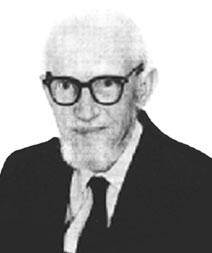 So, he went back to the library. Lo and behold, he learned about the work of Edward Howell. Howell was a doctor who graduated from the University of Illinois Medical School in about 1920, a brilliant doctor, great career, except for one thing–he was sick as a dog. I guess maybe if he were alive, he’d be diagnosed as having chronic fatigue syndrome, he was depressed, he was weak and dizzy, he couldn’t get out of bed. No interest in his work. He was fatigued, he had fevers, chills and sweats.
So, he went back to the library. Lo and behold, he learned about the work of Edward Howell. Howell was a doctor who graduated from the University of Illinois Medical School in about 1920, a brilliant doctor, great career, except for one thing–he was sick as a dog. I guess maybe if he were alive, he’d be diagnosed as having chronic fatigue syndrome, he was depressed, he was weak and dizzy, he couldn’t get out of bed. No interest in his work. He was fatigued, he had fevers, chills and sweats.
Now when a doctor’s sick, it’s scary. You always go to the best doctor and try to find out the best answer for what you’ve got. So, he went everywhere, from Columbia to Presbyterian to the Mayo Clinic. And they told him there’s nothing wrong with you, you’re just too stressed, you don’t really want to be a doctor, you need a psychiatrist. Even in 1920 they were telling people that.
He didn’t like that answer, he’d spent his whole life learning to be a doctor, here he was 24 years old with a medical degree and unable to function. Out of desperation–believe me, nobody ever goes to the natural therapists as first choice, they go out of desperation–Howell ended up in a spa run by a naturopath. The naturopath took one look at Howell and said, “You’re going on a diet of raw foods. Raw foods meaning vegetables, fruits, seeds, nuts, and grains.” Now Kelley saw three different people coming up with the same diet.
Howell was too sick to ask questions. He wasn’t thinking very clearly. He went on the diet because he was desperate, and in three months he was virtually completely well. As he got better, he felt strong enough to ask questions, and he asked this wonderful old naturopath, “What is it about raw food that got me well?” And the guy gave him one answer: Enzymes.
In 1920, we didn’t know too much about enzymes. We knew some. Enzymes are catalysts. They enable reactions to occur in biological systems with a minimum input of energy. You know, there are reactions that occur in the human cell that if it weren’t for enzymes would require 1-2 thousand degrees Centigrade: we would disappear in a puff of smoke. Enzymes allow reactions to occur with a minimum amount of heat and energy input. They increase the efficiency of both biological and nonbiological chemical reactions. When you cook food, this naturopath said, you don’t destroy the vitamins and the minerals and the trace elements, you don’t destroy the fat and the protein: there’s as much fat in a cooked McDonald’s as there is in raw beef. But you destroy the enzymes.
He told Howell what was known, that all biological enzymes are inactivated above 118 degrees. Well, that struck Howell as a pretty profound concept, and he made the same connection as Kelley made forty years later, that we were the only species of animal in the history of the world that cooks its food, and that might have a profound effect on our health. We all know about the vitamins, minerals, trace elements, proteins, fats and carbohydrates. We never think about the enzymes in food. Howell perceived, and so did his naturopath, and so did Kelley forty years later, that the enzymes in food may be the single most important nutrient in food: the nutrients being required for repairing or rebuilding the damaged tissue, for preventing disease–after all it was enzymes that are the metabolic machinery. And those enzymes may be used in the body for repair and rebuilding.
Certainly, Gerson’s work and Kelley’s own diet that he was following courtesy of his mother, prove that there was something in raw food that could lead to health. And it had to be the enzymes. Howell spent fifty years of his life documenting the effects of raw foods on human health. His studies are absolutely profound. He’s probably like Beard, one of the most brilliant men of the 20th Century, and like Beard probably one of the least well known because he was outside the orthodoxy and nobody paid any attention to him.
Dr. Kelley’s Own Experiments
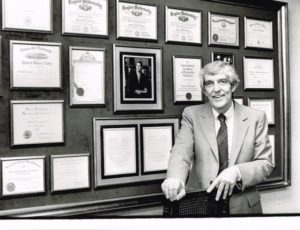 Dr. Kelley was doing pretty well. Had his diet down, he had his enzymes down, he understood raw foods, he understood pancreatic enzymes, and he was doing well. He was nine months into his therapy, the tumor was regressing, he was working nine hours a day seeing patients. Everything was going well.
Dr. Kelley was doing pretty well. Had his diet down, he had his enzymes down, he understood raw foods, he understood pancreatic enzymes, and he was doing well. He was nine months into his therapy, the tumor was regressing, he was working nine hours a day seeing patients. Everything was going well.
And then he started to get sick. He woke up one day feeling too tired, he canceled his patients and stayed in bed. The next day he felt worse. tired, fatigue, he thought he was getting the flu. He asked his mother, his mother said, just stay on the diet, stay on the enzymes, his mother was a pretty tough character, she said, you just keep doing the program. The third day he was sicker. The fourth day he started vomiting. This was a bit scary, because he would take one of his doses of fifty capsules of enzymes and would throw them up immediately. Kelly was a tough character. He’d take the fifty pills again and he’d throw them up again, and he had this big battle with his stomach, and by the end of the day he gave up. HE said, I just have intestinal flu, I’ll stay off the pills. So he stayed off the pills two or three days and he started to feel better. He said, okay, I can go back on my pills. And he was scared, he knew if he stayed off those enzymes, those tumors were going to grow. So after that, three or four days he felt fine, then suddenly he started getting sick again. He felt tired, then fatigued and lethargic, with fevers, chills sweats. And the fourth day on these enzymes he started throwing up his guts.
This was kind of scary again, because those pancreatic enzymes were his life-line and without them he was going to die. He had four young kids and if he died, they were going back to the orphanage, they had no choice. He stayed off the pills a couple of days and felt better. But as he stayed off the pills–and remember, Kelley was lucky in a very unlucky way because he had his own tumor marker sticking out of his belly–if he stayed off the enzymes those tumors started to grow. He didn’t like that too much.
On the enzymes, they’d start to shrink but he’d get sick. Off the enzymes, the tumors would grow but he’d feel better. On the enzymes, on the enzymes, the tumors would shrink, but he’d feel sick. This doesn’t make sense, he said. On the enzymes the tumors are going away, I should feel better. When off the enzymes the tumors grow and I should feel worse. On the enzymes, when the tumors break down I feel sicker.
He kept thinking about this, Kelley being a scientist -I’d have probably cried and gone to bed and forgotten about the whole thing. Kelley stayed up day after day after day. Kelley was a wonderful man. When he had a problems–I lived in his house for a year and a half and there were a lot of unsolved problems–and I can remember days when he wouldn’t let me sleep because something had to be thought of. I need about six or seven hours a night. He got about thirty minutes, so it was a pretty difficult thing to be around him physiologically. Also, psychologically and spiritually.
Kelley was trying to figure out this problem of why he felt worse when the tumors broke down, and one night in the middle of the night, 3 o’clock in the morning, he finally figured it out. He said, I know what’s happening! Tumor wastes are making me sick. Tumor wastes are poisonous! That’s what it is! And a light went off. He said, a lot of the symptoms that people are getting on chemo–now back in 1964 we didn’t have a lot of the chemotherapy agents but we certainly had chemo and people certainly got sick on it–Kelley said, it’s the darned tumor breaking down, I bet that’s why people get sick from the treatment for cancer, as the tumor breaks down they get poisoned by tumor waste.
Kelley said nothing, absolutely nothing on earth is more toxic to the cancer patient than dead tumor waste. That was his statement. And it seemed to be true. When off the pills, when the tumor would be growing, he’d feel better. When on the pills, he’d feel sick. He got a lot of symptoms. Fevers to 103, chills, sweats, almost like a very severe anaphylactic sickness like response, muscle aches and pains, he said it was the tumor waste! Now, that led to another investigation. Kelley was looking for some way to help the body get rid of tumor waste. And he went through the medical literature, he had to find some way, because he had to increase the efficiency of the program, he had to …the patient, in this case himself. to stay on those enzyme pills because those pills were the life-line. Well, he went through a number of medical journals and went through a number of medical text books and the thing that kept coming back to him was the thing that raises the eyebrows of the orthodox colleagues more than anything, and you people will probably laugh when I mention it, and that’s the coffee enemas.
Nothing in the history of the world has generated more controversy than coffee enemas. Kelley learned about coffee enemas ironically not from some strange esoteric health publication, but from the Merck Manual. Merck Manual said that coffee enemas were a therapeutic tool from 1899 to 1977. Kelly learned about them right in the Merck Manual. Now as doctors learned during the 1920s and 1930s, when you take coffee rectally, the caffeine stimulates the liver to release its toxins, it dumps its toxins much like a dump truck. It’s not surprising when you think about it. You take caffeine rectally, you can stimulate the gall bladder and the liver ducts to dump their waste.
This has been documented by very sophisticated radiographic studies–which just about thirty people have read. So coffee enemas seemed like the logical thing to do, and Kelley wasn’t too happy about that, being a very neat gentleman, but he figured he didn’t have any choice because he wasn’t just fooling with some esoteric research project with some student or some study, he dealing with himself, and his life depended on him. So very reluctantly he went to the store, he says he got his local Chock-Full of Nuts coffee, he didn’t use organic coffee the first time, and he bought an enema bag from the local pharmacy and very reluctantly and very gingerly, he made up his coffee and gave himself his first coffee enema.
Now Kelley was a smart man. Before he took his first enema, he went on his enzymes four or five days, until he was really feeling sick, he had a fever of 103, nausea, he was vomiting, he had muscle aches and pains, he really was sick. He wanted to see if these enemas would work.
He did an enema, and in half an hour his fever went from 104 to 99, his muscle aches and pains were resolved, and he felt almost normal. It was almost a miraculous occurrence in Kelley’s own mind, and from that day on he did coffee enemas and he’s still doing them today and he’s been doing them since that first day and he hasn’t missed a single day.
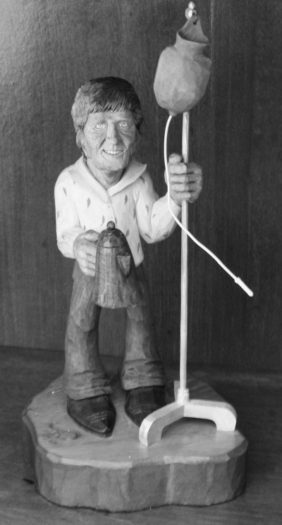
Dr. Kelley’s Famous Coffee Enema: Dr. W.D. Kelley, DDS, MS; woodcarving cir. 1974
So that was the third part of the Kelley program: first part, diet, second part pancreatic enzymes, third part coffee enemas. Crazy Dr. Kelley. But he got better. After about a year and a half, two years, his tumors were gone and he was back at work as an orthodontist. But when he hung up his shingle again, people didn’t come to him for straightening of their teeth, though. Kelley developed quite a reputation as the crazy dentist who had cured himself of cancer through his mothers’ nutritional program. And the first day he opened up his office, he got calls from people with cancer and with asthma, and multiple sclerosis, from the local out-lying towns there in West Texas, wanting to come by and go on that diet too.
Within a couple of years, Kelley was no longer treating people with crooked teeth, he was basically treating primarily advanced cancer patients with nutritional program. He developed such an international reputation that the local medical society had him thrown in jail in 1969. It had copies of his book which he was then publishing, absconded and burned…you don’t want to offend the AMA. There’s nothing offends the AMA more than a dentist who cures cancer. It’s not supposed to happen. It’s all right. I understand. I’m an M.D., and I’m a little offended by the idea too. I mean, it kind of bothers me that Dr. Kelley did it.

Author and Speaker, Nicholas Gonzalez, M.D.
Okay, so Kelley had an international reputation, he had this wonderful program: a diet of raw foods, vegetable, nuts, seeds, grains. He had the wonderful pancreatic enzyme–he added other vitamins and minerals to make the enzymes work better, with coffee enemas, and he was doing pretty well. But he wasn’t doing well enough. And Kelley always said and I always say, you don’t learn from your successes, your successes make you feel arrogant and wonderful, and they please your mother. But you learn from your failures.
By about 1969-70, Kelley was probably getting about 50% of his patients well. The bad news is, he was losing about 50%. He couldn’t figure out why–he was pretty pleased because most of his patients were pretty sick, but he couldn’t figure out why he was losing them. And he’d try out everything on a patient who was failing, he’d increase the amount of grains, decrease the amount of grains, give more juices, give less juices, change the relationship of beans to rice, but some patients, no matter what manipulation he did, they’d do badly. And one of them was the woman who was going to become his second wife…
To be continued…
